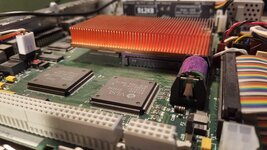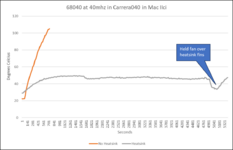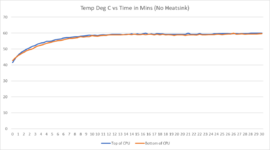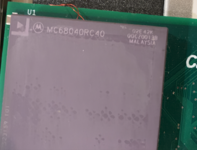Like I said, so I can read the markings?
I just label the underside of the heatsink. It's not a difficult problem to solve.
Like I said, so I can read the markings?
Problem solving needs a problem to solve.I just label the underside of the heatsink. It's not a difficult problem to solve.
A fan would be a better bet. I'd use the extra space for even a slow fan. Running a 12v fan at 5v is near silent, but moves enough air to vastly improve heat transfer.I assumed when ymk said tiny he also meant the height, as you could definitely use a taller heatsink in a Quadra 700/650/900/etc without issue. What would be interesting is some tests of taller heatsinks to see how much difference that really makes with an 040 running at 40MHz. I don't have a thermal imaging camera / probe thermometer to test this but I guess a cheap sensor could be used to take measurements for that sort of test.
How about passing a zip tie through the gap between the clips and pulling it?Adding my two cents for removing the clips:
I've had good luck abusing a chip lifter (like a wiha 26810) and prying the clips horizontal to the board. The upward curve helps leverage and makes it a little less likely you'll gouge headfirst into the board if you slip.
I assumed when ymk said tiny he also meant the height, as you could definitely use a taller heatsink in a Quadra 700/650/900/etc without issue.

Ultimately, unless you can remove the heat from the heatsink, a larger heatsink primarily acts as a reservoir and delays reaching peak temperature.
I assumed when ymk said tiny he also meant the height, as you could definitely use a taller heatsink in a Quadra 700/650/900/etc without issue. What would be interesting is some tests of taller heatsinks to see how much difference that really makes with an 040 running at 40MHz. I don't have a thermal imaging camera / probe thermometer to test this but I guess a cheap sensor could be used to take measurements for that sort of test.

I have to admit I'm slightly shocked - an 040 shouldn't run at anything near 100°C - it should crash way before that? I'll check a datasheet ...I recently added a Bolle Carrera040 to my IIci, using a 40mhz 68040 I bought from what I understand to be a reputable supplier on eBay. Everything worked fine but I was surprised at how hot the processor was to the touch. I ended up affixing a thermistor to the bottom of the processor, using very fine gauge enameled wire to pass through the processor pins, to see just how hot it was getting.
I was pretty surprised at how quickly the processor temperature ramped up. Admittedly I was trying to stress it out a bit by running some Speedometer tests on loop, but even after stopping the tests there wasn't much of a drop in temps. I then affixed a 50mm x 50mm x 20mm aluminum heatsink from Amazon using some thermal paste. I didn't have any thermal glue so I temporarily just affixed it with Kapton tape. The differences were dramatic - Temp rampup was much slower and hovered around 50C or slightly lower. I hammered it with way more loops of Speedometer tests (I pulled the plug on the tests without the heatsink when I saw temps get up to 105c or so) and the temps held firm. I played around with blowing a fan directly over the heatsink and that got temps down to sub 40C.
I have some thermal glue coming and I am going to attach a fan to the heatsink to keep temps as low as possible.
View attachment 64498

Yup, max junction temperature 110°C, I'm astounded it was still running with a measured 105 on the exterior of the package, even if it was the metal underside. How accurate is your thermistor and are you using the basic linear calculation to get the temperature, or the more fancy nonlinear formula?
If you want to ballpark check, the phase change in boiling water holds the temperature at close to 100°C so if you boil some water in a pan that should be near 100°, although you might want to waterproof the thermistor to stop water messing with the resistance.



